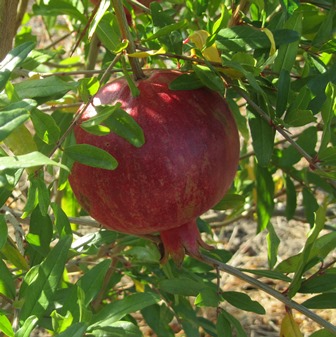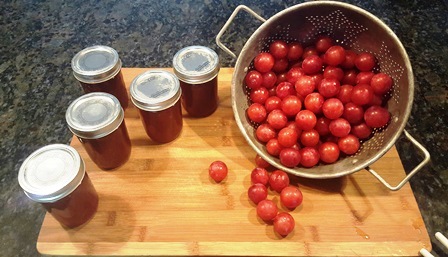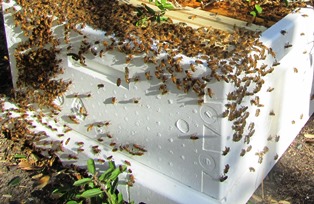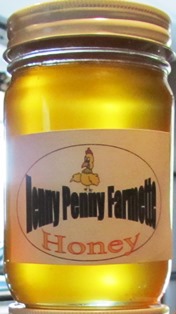Pomegranate Seeds–A Sweet Explosion on the Tongue
Strolling through our small orchard today, I cut into a pomegranate to check on the seeds–the edible part of the fruit. To my surprise, they had turned ripe. Inside, the seeds were gorgeous red jewels, plump and juicy. The sweet juice in the seeds carries a powerful antioxidant punch, too; it’s loaded with Vitamin C, Vitamin K, fiber, potassium, protein, and folate.
You might wonder about ways of cooking with pomegranate seeds. How about tossing them into citrus or a green salad, pairing them with goat cheese on a crostini, or sprinkling a few on poached pears dipped in chocolate, or incorporate them into a Mediterranean couscous with cashews or pistachios?
I think I’ll make some pomegranate jelly–it tastes great on toast, makes an excellent foil for goat cheese, and also creates a moist and delicious glaze for chicken.
The hardest part of making the jelly is separating the seeds from the white pith that holds the seeds in place inside the leathery peel.
The jelly recipe consists of few ingredients: pomegranate juice, sugar, water, and classic pectin. Here’s how I make the jelly.
POMEGRANATE JELLY RECIPE
Ingredients:
3 1/2 cups pomegranate juice (well strained to remove all the particles)
5 cups granulated sugar
6 tablespoons classic pectin
Directions:
Prepare boiling water canner and wash eight to ten half-pint jars in the dishwasher.
Place rings and lids in a pan of simmering hot water.
Cut one end of the pomegranate off to expose the membranes and seeds.
Section the pomegranate and scrape the seeds out into a medium to large bowl.
Repeat the process until you had several cups of seeds.
Rinse well and then run the seeds through a juice extractor.
Strain out the juice through a jelly bag or multiple layers of cheesecloth. Note: The juice stains, so take care to protect kitchen counters and clothing.
Put the juice and pectin into a large pot and bring to a boil, carefully stirring to blend in the pectin.
Add sugar and stir until completely dissolved and boil for one minute at a roiling boil that cannot be stirred down. Ladle off foam, if necessary.
Ladle jam into clean, hot jars leaving one-quarter inch head space. Attach hot lids and then the rings. Tighten to finger tight.
Lower the filled and sealed jars into the canner. Process for 10 minutes at a roiling boil. Remove and let cool.
* * *
If you enjoy reading about farmette topics (including gardening, beekeeping, and delicious recipes), check out my cozy mysteries A BEELINE TO MURDER and also THE MURDER OF A QUEEN BEE in the Henny Penny Farmette series (from Kensington Publishing).
These novels are available through online retailers such as Amazon, Barnes & Noble, Kobo Books, and Walmart as well as from traditional bookstores everywhere.
See, http://tinyurl.com/hxy3s8q
Now available in mass market paperback, this debut novel launched the Henny Penny Farmette series of mysteries and sold out its first press run.
See, http://tinyurl.com/h4kou4g
The second cozy mystery in the Henny Penny Farmette series, available Sept. 27, 2016, is now available on Net Galley (netgalley.com) for professionals and readers who write reviews. The book may be pre-ordered as well. Click on the link under the image.
Making a No-Fail Wild Plum Jam
An amazing wild plum tree sprouted up and grew tall at the back of our property with a full canopy of gorgeous burgundy leaves. This, without any attention or coddling from us. It’s now three-years-old and loaded with red plums.
The fruit itself is quite juicy and sweet, but the skins are tart. I made a small test batch of five jars and then waited 24 hours to sample the jam. After I tasted the test jam and realized how exquisitely delicious it was, I vowed to can at least a couple dozen jars.
I got out cases of unopened jars and lids and ran the jars through a hot water wash cycle in my dishwasher. Then I rinsed the plums under water and pitted them before making the fruit into jam. My plan is to not only enjoy eating the jam throughout the summer and fall but to pack jars of it into food baskets for holiday giving this year.
This jam is perfect for spreading on a slice of toast or a croissant. The sweet-tart taste means it would nicely accompany chicken or pork. The taste is sweet but tangy. The texture is lighter and smoother than strawberry.
RECIPE: WILD PLUM JAM
Ingredients:
5 cups wild plums (washed and pitted)
3 cups sugar
1/4 cup lemon juice
1/3 cup water
5 Tablespoons Classic Pectin
Directions:
Place the pitted plums into a large cooking pot and add all ingredients except pectin.
Stir well to combine.
Cook on high and bring the plums to gelling point. Stir constantly for 15 minutes as mixture thickens.
Sprinkle in the pectin by spoonfuls and stir after each addition to mix well.
Ladle jam into hot jars. Leave about 1/4-inch at the top. Attach lids and screw rings and then process in boiling water for 20 minutes according to your canner instructions.
Jars, Lids, Bottles, and Stoppers
Our world-class neighborhood beekeeper checked my hives on Sunday and told me that potentially, I could have 100 pounds of honey to harvest during the flow this year. Each frame will produce roughly 40 pounds of honey and each hive holds 10 frames.
If the hive is robust and extenders (additional boxes of frames) have been added, they may also hold honey, although a good beekeeper never takes all the honey. The bees have to eat, too.
It was pretty clear that I need to get some jars. Lucky for me, he and his wife already have found a good supplier. The company they use is located in the Bay Area.
Today, she and I traveled headed toward Oakland, a drive of about 45 minutes, to where Saxco International operates its corporate offices and huge warehouse at 155 98th Avenue in Oakland. See, http://www.saxco.com.
Jars aren’t the only type of packaging the company offers. From wine, spirits, beer, and vinegar bottles and stoppers; pharmaceutical containers; bar glassware that can be monogrammed or labeled; and food jars and lids, this company’s offerings are impressive.
We waited close to an hour for the warehouse worker to load the plastic-wrapped cases onto a pallet, drive the forklift over to her truck, and load the whole shebang onto the bed. Although the boxes towered above the cab, we made it home with no problems.
And just when I was feeling optimistic about being better prepared to deal with all that honey, it occurred to me that I’m going to need a lot of cheesecloth to strain it, buckets to drain it, and labels for all those jars!
Could a honey separator be in my future? I’m beginning to think that beekeeping could become an expensive hobby. Ah, but a sweet one: honey never goes bad and the honeybees pollinate my fruit trees, which are loaded with fruit. Next on my list–jam jars.
 Facebook
Facebook Goodreads
Goodreads LinkedIn
LinkedIn Meera Lester
Meera Lester Twitter
Twitter










